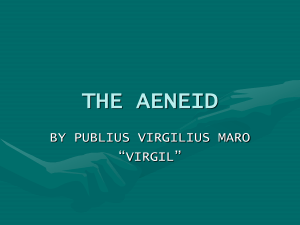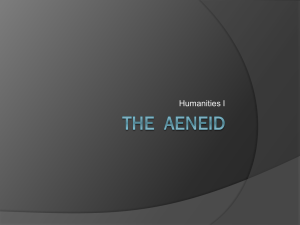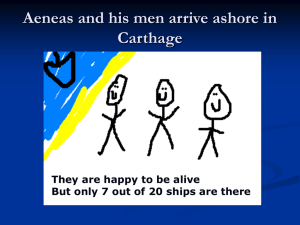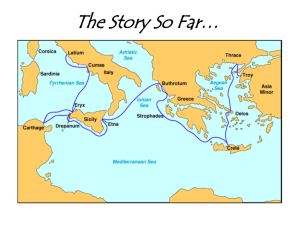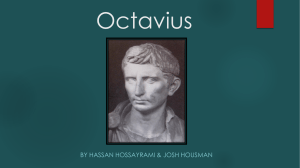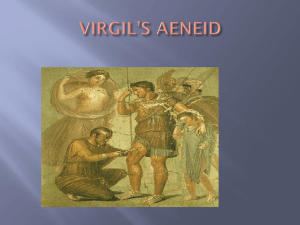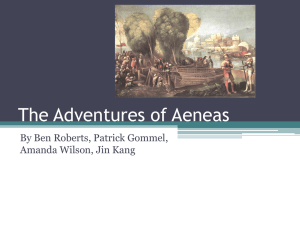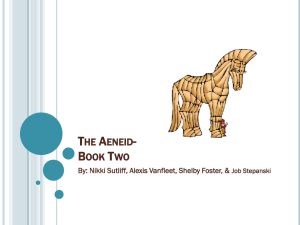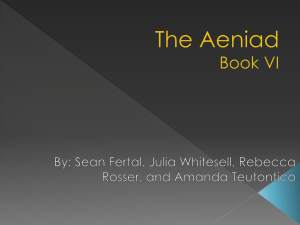File - Latin and Classical Studies at BCSS
advertisement
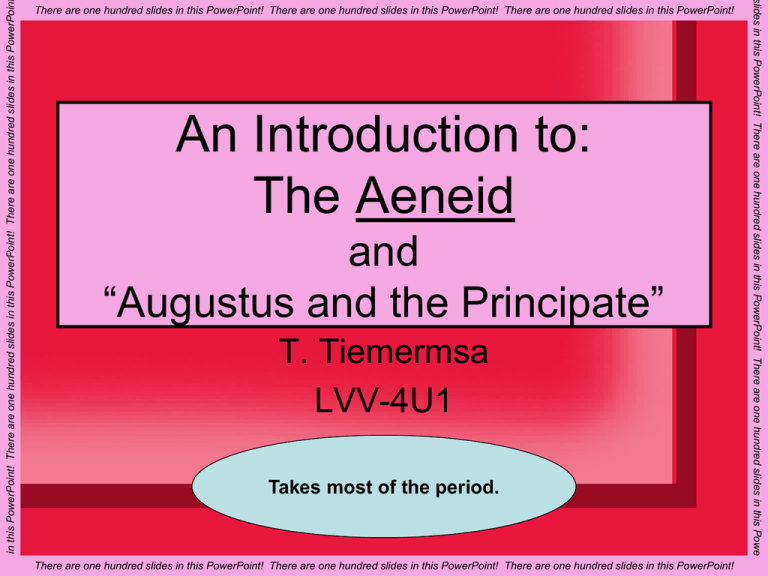
des in this PowerPoint! There are one hundred slides in this PowerPoint! There are one hundred slides in this PowerPoin An Introduction to: The Aeneid and “Augustus and the Principate” T. Tiemermsa LVV-4U1 Takes most of the period. There are one hundred slides in this PowerPoint! There are one hundred slides in this PowerPoint! There are one hundred slides in this PowerPoint! slides in this PowerPoint! There are one hundred slides in this PowerPoint! There are one hundred slides in this PowerPoin There are one hundred slides in this PowerPoint! There are one hundred slides in this PowerPoint! There are one hundred slides in this PowerPoint! Publius Vergilius Maro Studied rhetoric, medicine, and astronomy at early age Abandoned those pursuits to study philosophy Spellings and variations of names a. Virgil b. Vergil c. Virgilius Livius Codex You do not have to copy all of this information. Augustus & the Principate Another Level to the Aeneid (Some background information) A National Poem • Written at a time of optimism, to represent a new and exciting time. • It gave the Romans an equivalent to Homer and explored what they were like, what they should be like and what they could achieve. • The majority of Virgil’s life, Rome was in a period of civil war, or civil war was around the corner. • The Aeneid combines the Homeric age, with the Augustan period, merging myth with historical fact. IMPORTANT: • Virgil manages to include the past, present, and future, in a way that we do not see in Homer, through the use of prophecy, myth, Roman legends, and finally, Stoic (“virtue is sufficient for happiness”) philosophy used by the humans and gods in the poem A Brief History of Rome… • After the founding of Rome, there were seven kings – most were Etruscan • The last king was ousted by Brutus and the Republic was created in 509 B.C. • The Romans were very proud of the way Rome was run and feared those who sought absolute power. This was the problem with Caesar. Social Unrest and Revolt: Before the Death of Caesar Emergence of the First Triumvirate: Julius Caesar, Crassus, Pompey Crassus killed by Parthians 53 BCE Senate support of Pompey versus Caesar Crossing the Rubicon – civil war b/t Pompey and Caesar Defeat of Pompey Caesar made dictator 47 BCE Julius Caesar Julius Caesar Initiates Reforms • Adopts Egyptian solar calendar – Julian Calendar with 365 days (July) • Libraries, Theatres, Public Works • Citizenship to people in Gaul and Spain Assassination – Killed by senatorial opponents (led by Brutus and Cassius – hailed as saviours of the Republic) – Instigated by his usurpation of power and their fear that he would become emperor – Died March 15, 44 BC • Stabbed by 20 senators • Brutus and Cassius After Caesar dies: • At this point Octavian (Caesar’s nephew) returned to Rome to claim his inheritance • Octavian returns with Marc Antony and fights a civil war against Brutus and Cassius. Brutus and Cassius are defeated! Suetonius wrote: “Octavian showed no mercy to his beaten enemies. He sent Brutus’ head to Rome to be thrown at the feet of Caesar’s statue.” The Second Triumvirate OCTAVIAN ANTONY LEPIDUS • There is another possibility of civil war with Antony over leadership, but Octavian splits the empire three ways between himself, Antony, and Lepidus - Tension between Octavian and Antony • Tension rises with Antony and Octavian but Antony marries Octavian’s sister • Lepidus and Octavian fall out – Octavian now has complete power over the west, whilst Antony has the East. • Antony had been living in the East with Cleopatra, who had an illegitimate son with Caesar called Caesarion, Antony called him “King of Kings” – direct attack on Octavian’s inheritance. • Octavian used this to portray Antony as a defector from Rome, who had created an independent Eastern Empire. • When senators loyal to Antony attack Augustus in the senate, Augustus reacts so strongly that they flee to Egypt. • Augustus then claimed that they were setting up their own senate in Egypt. • Octavian then seized Antony’s will and published it – within it Antony stated he wanted to be buried next to Cleopatra in Egypt • Octavian showed this to be a betrayal of Rome and his sister, and waged war against Cleopatra – not another civil war. Battle of Actium • Cleopatra and Antony were easily defeated in Egypt. • They both committed suicide and their son and Caesarion were killed by Octavian. • Octavian had now become the single most powerful man in the Roman world and had to protect his position. • Aware of the Romans’ feelings about dictatorship Octavian did everything he could to show he did not want absolute power. • If he was ever bestowed with honours, he made it appear as though it was the senate’s idea and often refused. • He even claimed he would resign at one point, and the senate fearing another civil war (by those who sought his position) begged him to stay. Empire • Octavian “restores” power to the Senate • Awarded titles of Augustus and imperator • Expands into Balkans, Germany • Establishes Praetorian Guard Caesar Augustus (Octavian) The Customs of the Ancestors • More power than any other citizen, yet no one could claim he wanted to be king or dictator. • Augustus - return to the golden age, or returning to the mos maiorum, customs of the ancestors. • Long period of civil war, the Romans were optimistic and believed Augustus could save them. • Augustus promoted piety, marriage, proper behaviour, peace, family life and started a building regime. Augustan Propaganda • Augustus presented himself as the ideal Roman citizen – pietas, auctoritas (like Aeneas) • He wanted to be viewed as a father to the Roman people and under Maecenas, his friend, many poets were encouraged to write pro – Augustan literature. • Maecenas supported and influenced struggling poets. • This literature highlighted and praised Augustus’ ideals, e.g. Horace’s ode on the battle of Actium. The Aeneid • Virgil attempted to write an epic both showing the greatness of the Roman race (and what they could become) and linking the hero with their hero – Augustus. • The legend was developed, made more well known and used to highlight a link between Augustus and both Aeneas and the gods. • Augustus is represented as the culmination of years of history and his rule is made to appear fated. • He would make Rome glorious again. Refer to the Fill-in-the-blank section. I. The Aeneid: • written in 12 books in Homeric fashion (it is an EPIC) • not like the Iliad (an inherited part of Greek national consciousness) – it was a deliberate attempt to glorify the nation and to elaborate on the ideals and achievements of the Roman state under its first emperor, Augustus – it was a work of Imperial PROPAGANDA – all events of the Roman past (esp. the civil wars) found their fulfillment in the peaceful and prosperous age of Augustus – it is a legendary narrative – a story about the imagined origin of the Roman nation in times long before the foundation of Rome itself Virgil’s Masterpiece • Virgil spent 11 years on this poem, but unfortunately died before he was finished (20-22 unfinished lines) • He wanted the poem to be burnt, but the emperor Augustus would not allow this and had it published after his death. • The poem is now over 2000 years old and is still considered to be one of the greatest poems ever written… II. Opening Lines: “ARMA VIRUMQUE CANO” “I sing of arms and the hero” The first 6 books, roughly, of the Aeneid relate Aeneas's-- 'the man's'-- wanderings after the fall of Troy, just as Homer's Odyssey narrates Odysseus's various peregrinations on his return voyage home. The last six books, concern the bloodshed and battle-- 'weapons'-- which greet Aeneas in his quest to found a new city on the coast of Italy. • Next, Virgil invokes the muse. “I pray for inspiration…”. • Vergil enlists the muse of Epic, Calliope, as a companion in the enterprise of recalling Aeneas' story. Vergil singles out Juno, queen of the gods, as the impetus for the events leading to both Aeneas' fantastic voyage and subsequent warfare; it is her wounded numen, her injured sense of self as a goddess and supernatural being, that spurs her vendetta against the mortal Aeneas, and which turns the wheels of the divine machinery omnipresent in the epic. First 11 Lines, Dactylic Hexameter Scanned After which, he poses an epic question. “Is it in a god’s nature to nurse an abiding fury?” In other words… “Can divine beings have such enormous wrath?” The final line-- "can immortal souls indeed harbor such terrible wrath?"-- is a novel twist to a prologue, a sudden anxious query on the part of the narrator about the ramifications of the story which he causing to be told. It is true enough that the story of Aeneas may be seen as a triumphant tale: Aeneas founds the city that shall, in time, become the most powerful in the western world. But throughout his journey Aeneas encounters so much wrath, ira, both from mortals [Dido, Turnus, Mezentius] and immortals [Juno, Aeolus' winds, Allecto] that this violent, intemperate force threatens to color darkly our view of the poem. III. Characters: TROY AENEAS: • son of Venus and Anchises • husband of Creusa • father of Ascanius • leader of the Trojan quest for a new homeland • Trojan prince, allied to, but not descended from Priam ASCANIUS: • son of Aeneas and Creusa • founder of Alba Longa • also called IULIUS – to relate him to the Julian family of Julius Caesar and Augustus DIDO: • daughter of Belus, King of Tyre (Phoenicia) • her husband, Sychaeus, was murdered by her brother, Pygmalion • she was warned in a dream by Sychaeus to escape (went to Libya) and founded Carthage IV. Stock Epithets • • • • • • • • Aeneas, the great of heart steadfast, Aeneas Aeneas, the true Aeneas, son of a goddess Juno, the generous Juno, Queen of all the divine Venus, the kind life giver Venus, the Cytherean (Cythera – island near Greece where she was worshipped) V. Epic Similies • picture of Neptune calming a storm – Neptune is like a statesman calming a noisy assembly • when Aeneas comes to Carthage, he compares the workmen to bees • Queen Dido is likened to Diana • When the mist around Aeneas dissolved, he is likened to a work of art in ivory or in gold and silver VI. Rules of Conduct • “Avoid Excess” – the Aeneid depicts many examples of thoughtless excess leading to disaster (esp. when someone is carried too far by an exclusive love for some person or thing) • “Be True” – loyal to the gods, to the homeland, and to family, friends, and dependents [i.e., Aeneas, the True] Aeneas arrives at Carthage Banquet with Dido at her Palace Venus sends Cupid to Dido Dido Meets Ascanius Aeneas Relates his Story to Dido Hector Appears to Aeneas in a Dream: “Save Yourself!” Close-up Creusa tries to Restrain Aeneas Aeneas Gets his Family Anchises holds the household gods You follow behind, Woman “Creusa, if you keep on dancing, you’re going to get lost!” “Hey, where are you Creusa? Gee, she was right behind me!” Trojan Refugees at the Shore Penates to Aeneas “Leave Crete, It’s not the Destined Land!” The Cyclopes at Sicily Aeneas and Followers Flee Cyclopes Dido Shows Carthage to Aeneas Scenes from the Year spent with Dido Aeneas and Achates Building Carthage Aeneas and Dido in their “Marriage Cave” A False Marriage Dido Burns with Love for Aeneas Mercury Calls on Aeneas Dido confronts Aeneas and Begs Him to Stay Aeneas sails from Carthage Dido Watching Aeneas Leave Dido Abandoned Dido Prepares for Suicide Dido Commits Suicide The Funeral Pyre The People of Carthage Lament the Death of Dido Farewell to Dido Aeneas has Left Carthage Funeral Games for Anchises at Drepanum, Sicily The Boxing Contest Aeneas and Men Sail Past Scylla and Charybdis Passage to the Sibyl’s Cave Descent to the Underworld Venus Disguised as Huntress “These people work like bees!” 1. Primarily, story is fiction a. No Trojans or Greeks settled in Latium in 12th Century BC b. First signs of civilization are from much later c. Ethnically, Romans a are blend of Etruscans and local peoples in the Italian region (not Greek or Trojan) Aeneas and Sibyl sacrificing to gods of the underworld. 2. Influenced heavily by Homer’s Iliad (which is based on at least some fact) and Odyssey (but Aeneid is still distinct; more to come on that later) 3. References to events and people from centuries just preceding composition are accurate 4. Although difficult to determine for certain, seems that Romans saw as a fictionalized account of true events Shared Characteristics with Homeric epics 1. Considered literary or secondary epic (to set apart from primitive or primary epics, like Homer’s) a. Shows that Homer’s works were oral, improvisational b. Virgil’s created in the epic tradition but written and designed to be read rather than recited Circe transforms Aeneas and men into beasts. Aeneid 8.10. 2. No repetition of formulas (as in Homeric works) but imitation of Homeric language 3. Similar heroic characteristics, though they do differ in some ways a. Homer celebrates individualism (i.e. Achilles) b. Virgil celebrates working within society and sophistication Trojans crown Latinus king. Detail. Aeneid 7.195ff. Venus and Neptune. Aeneid 5.216. 4. Book 12 5. Recurring and Descriptive Language i. Iliad (swift for Achilles, etc.) ii. Aeneid (furor and furere [verb form]--also symbolic) 6. Recurring images i. Iliad (fire, gods speaking directly to humans, gore) ii. Aeneid (snakes, wounds, fire, hunting, storms) Differences from Homeric epics Trojan Horse. Aeneid 2.67ff. 1. Symbolism is not as evident in Homeric works 2. Symbolism and symbolic meaning important in Aeneid (especially in reference to Roman history and current events) a. Aeneas’ journey to found Rome follows to link with Octavian/Augustus b. Destruction of Troy and wanderings of Aeneas = history of Rome in 1st century B.C. (collapse of the Republic, creation of peace/order by Augustus via creation of the Empire) Aeneas' voyage from Delos to Naxos. Aeneid 3.124ff. c. “Civil war” between Trojans and Italian allies = Roman civil wars (Brutus and Cassius v. Mark Antony, Octavian/Augustus, and Lepidus and Mark Antony v. Octavian/Augustus) d. Aeneas’ relationship Dido reproaches Aeneas. Detail. Aeneid with Dido = Mark 4.305. Antony’s relationship Horrible History – clip with Cleopatra MA and C Penates appear to Aeneas in a dream. Detail. Aeneid 3.147. 3. Philosophical basis in Aeneid is not present in Homeric epics a. Use of stoicism i. School of thought teaching that self-control, moral/emotional strength, and detachment from distracting emotions would make one a clear thinker, unemotional, and unbiased ii. Developed in Hellenistic period iii. Very popular among educated elite at the time iv. Relies on jus naturale (“natural law”) [some things are just because they are—i.e. “All men are created equal…” based on “We hold these truths to be selfevident…”], which would be included and influential on Christianity Latinus' farewell to Trojan ambasssadors. Aeneid 7.274. Sow with 30 pigs. Detail. Aeneid 8.68. b. Examples: i. Connection between fate and founding of Rome (Book 1) ii. Preference by Zeus for Roman race (Book 1) iii. Anchises’ discussion of nature and human existence (Book 6) Assigned Task: Watch Video Clip Located on the Class website: Aeneas Narration Read “The Adventures of Aeneas” in Edith Hamilton’s Mythology and answer the accompanying questions.
